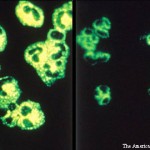Novel Therapeutics
Dr. Seo turned next to novel therapeutics coming down the pipeline. Peresolimab, a programmed cell death 1 (PD-1) stimulator, showed benefit in RA.11 This drug does the opposite of PD-1 inhibitors (checkpoint inhibitors), which are used to treat various cancers.
“You’re probably thinking that stimulating a checkpoint maybe isn’t such a smart idea,” Dr. Seo noted. “That said, we had the same thoughts about TNFi and cancer risk decades ago and that never really panned out. We need to wait for more data to know if this is an important risk.”
ABBV-3372 is a novel hybrid molecule that also showed benefit in RA.12 Dr. Seo explained, “Part of the molecule is basically adalimumab, and it uses that to home in on activated immune cells expressing TNF. Then, it drops off a payload of a GC receptor modulator, delivering GC doses to cells that actually need it, while leaving other cells alone.” Most interestingly, the study showed that there may be prolonged benefit even after discontinuation of the drug. “This is really exciting when we think of SLE or vasculitis, diseases commonly treated with high doses of GC. This might represent a path forward for them.”
Dr. Seo also touched on brepocitinib and bimekizumab for the treatment of psoriatic arthritis, deucravacitinib for SLE, and riociguat for diffuse cutaneous systemic sclerosis. We look forward to further data that will help determine each drug’s future role in the treatment of our patients.13–17 Baricitinib, on the other hand, will no longer be pursued by the drug company as a potential treatment for SLE due to lack of efficacy in clinical trials.18,19
“This brings us back to the question of whether we know what the ideal end point is for SLE clinical trials,” he said.
Polymyalgia Rheumatica
In February 2023, the FDA approved sarilumab for the treatment of adults with polymyalgia rheumatica (PMR) for whom glucocorticoids have proven inadequate or who cannot tolerate a glucocorticoid taper.20
A phase 3 trial showed significant efficacy in achieving sustained remission and steroid sparing in patients with relapsed PMR.20 “The most common adverse effect was neutropenia,” noted Dr. Seo, “but these patients didn’t get serious infections. It still seems well tolerated, even in an elderly population.”
A Fascinating Case Report
Dr. Seo concluded with an exciting case report that describes a potential curative therapy for ankylosing spondylitis (AS). A patient with severe, refractory AS who had failed multiple immunosuppressants, as well as hematopoietic stem cell transplantation was treated with a cytotoxic anti-TRBV9 antibody, which depletes TRBV9-positive T-cells (implicated in the pathogenesis of AS).21 Investigators reported that the patient achieved remission within three months, has remained in remission for four years and was able to discontinue TNFi with continuous use of the study drug (three infusions per year).



